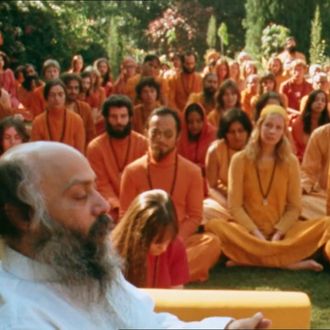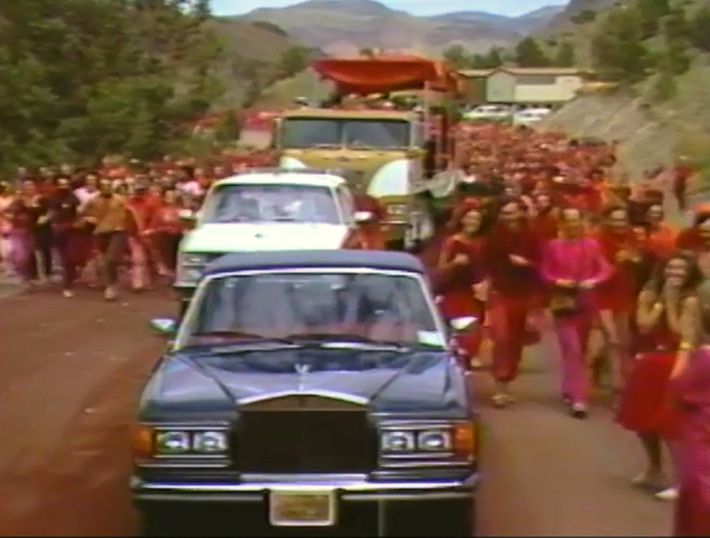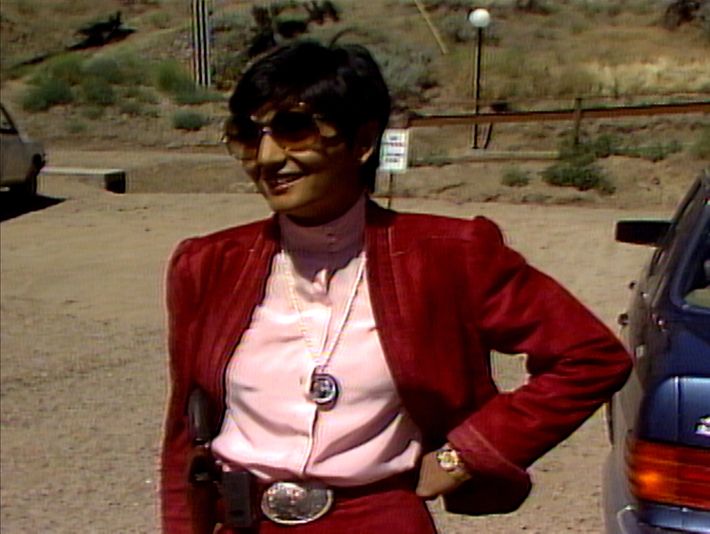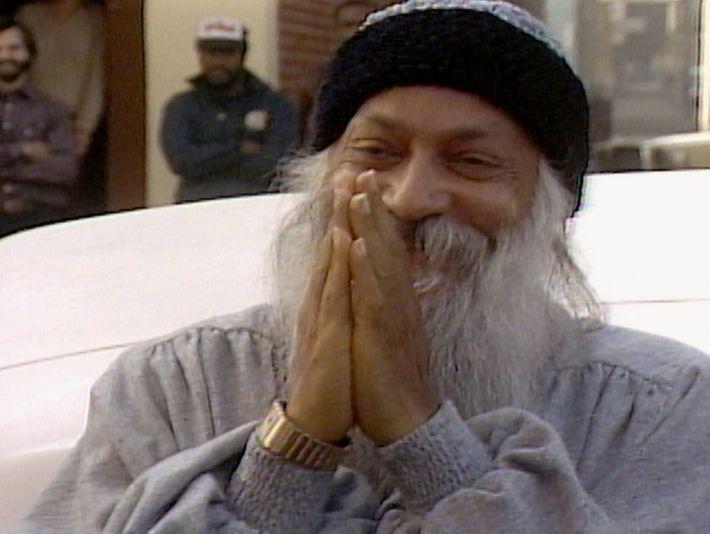
Netflix’s new documentary series, Wild Wild Country, opens with a clap of thunder and a large man in overalls named John Silvertooth telling a chilling tale.
The year is 1981. One day, John is walking to the post office in his sleepy, 40-person town of Antelope, Oregon, when he sees a man who’s clearly not from there. “You could spot Europeans by the shoes,” he recalls. “They wore fashionable leather shoes — not cowboy boots.”
This fashionable European man gives John a cryptic warning: “They’re coming.” At this point, we’re barely two minutes into the episode, but the anticipation is high enough to make you scream into your pillow: Who? Who is coming? And do they have nice shoes, too?
What follows is real-life video footage of hordes of people, all dressed in head-to-toe red, marching through the town of Antelope in slow motion like a monochromatic zombie army. They wear red puffer coats, red turtlenecks, red jeans, and red sneakers. They look a lot like me, or you, or this Mansur Gavriel model. But they’re not. They’re members of the Rajneeshpuram cult, and they’re devoted to a slender Indian man with a long white beard who calls himself the Bhagwan.
Turns out, the Bhagwan has just bought a 64,000-acre ranch in Antelope for his commune of thousands to live, laugh, and love. He will pull up to the tiny Oregon town in a white Rolls-Royce (one of the alleged 85 that he owns) and leave four years later in a private jet in an attempt to flee his own arrest.
Wild Wild Country tells the story of what happened between 1981 and 1985 in Antelope, Oregon. It includes, but is not limited to, mass poisoning, wire-tapping, immigration fraud, sex, drugs, and attempted murder. But despite all the show’s mind-blowing details, what I can’t stop thinking about is this cult’s clothes. Why do they dress this way? Has a cult ever looked this good? And can I copy their style in my own life?

When visitors arrived at Rajneeshpuram, they were instructed to leave not only their names but also their civilian clothes at the door. Instead, they wore clothes “of the colors of the rising or setting sun” — red, orange, or purple — as well as beaded necklaces with a locket containing a picture of Bhagwan’s face. Rajneeshpuram even had a monochromatic clothing boutique where members could shop.
According to posts on Reddit, items sold at the boutique seem to be sourced from all over. One user reports that Meier & Frank, a popular department store chain in Oregon, even had a “dedicated buyer” just for red items at one point. In other words, “one person in charge of making sure one of the biggest department store chains in the area had enough red towels, bed sheets, T-shirts, etc.”
The impetus behind the group’s color coordination is not made clear in the documentary. (Saffron is the most sacred color of Hinduism, and the Hare Krishna wear all orange.) But whatever the reason, the results feel oddly on-trend for 2018, which perhaps explains why the look has garnered so many responses online. Personally, I’ve been dressing like a Rajneeshee for years without even knowing it.
Monochrome has been bubbling up as a fashion trend for the past few seasons. Givenchy, for example, did an all-red collection for fall 2017, and Dior showed an entire navy-blue collection that same season. The spring 2018 runways were particularly monochrome-heavy as well, meaning the trend will soon make its way to the streets — now almost certainly with the help of Wild Wild Country’s influence. Madewell’s homepage on Wednesday looked like a scene right out of the series.
Stylish viewers of Wild Wild Country may love this cult’s monochrome look because it feels like their own right now, but the fashion industry also has a long history of obsession with cults. After all, what is fashion but a bit of a cult itself? Not only does the fashion world encourage devotion to brands, creative leaders, influencers, and (divine) objects, but fashion people constantly use the term “cult” to classify trends. In fact, “cult” has become synonymous with “hype,” the word often used to describe what’s driving customers into stores today. How else can we explain long lines for things like a Supreme hand ax?

If you think about it, the fashion industry and cults have eerily similar motivations. As Rhonda Garelick wrote about the infamous cult leader Charles Manson in December: “Like fashion’s best marketers, he knew how to turn his vision — and himself — into a distinctive product, how to incite desire for that product, and how to use people’s desires — to be special, to belong, to be superior — to fuel his own agenda.” In other words, Charles Manson was his own kind of influencer.
Unlike historically anti-capitalist cult leaders (or traditional Hindu communities, for that matter), Bhagwan loved material things. He did not discourage his followers from indulging in them, either. “My conception of a beautiful, flowering being is not that of austerity, it is of luxury,” he said once during a Good Morning America interview.
As a result of Bhagwan’s lax policy on luxury, he attracted followers who wanted to free their minds and keep their wallets fat. (Read: well-educated and white.) A second group of Rajneeshees referred to as “The Hollywood People” eventually emerged in Los Angeles, led by Francoise Ruddy, the ex-wife of The Godfather producer Al Ruddy. The Hollywood People threw lavish fundraising parties and lured Bhagwan into their good graces by donating hundreds of thousands of dollars to the cause. They also bought Bhagwan a million-dollar diamond Rolex watch.
“He was like this blackbird that attracts shiny things,” says Jane Stork, who once attempted murder on Bhagwan’s behalf.

Bhagwan wasn’t just a guru; he was a style gawd who led arguably the most well-dressed cult in history. He also knew exactly what he was doing. Monochrome allowed the Rajneeshees to feel both connected to a community and separate from the rest of the world. It was a declaration of identity. Like Overalls John said at the beginning: One look at these people, and he knew that they were different.
Before his death, Bhagwan renounced the Rajneeshee religious codes, giving his followers the option to wear other colors. (One woman seemed orgasmic at the thought of wear turquoise again; alas, the color quickly sold out at the Rajneeshpuram boutique.) But strangely enough, none of the other characters in Wild Wild Country changed their wardrobe, despite their new freedom. In fact, followers of Bhagwan — or Osho, as he’s called today — still wear shades of red.
I think I understand why. The truth is, like escaping society for the wilderness of Oregon, monochrome feels like a way to radically simplify and focus your life — an ideal look for a cult of one.





